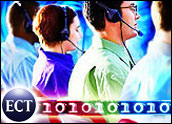
This article was originally published on July 18, 2008, and is brought to you as part of our Best of ECT News series.
Working from home has become an acceptable option for a wide range of professionals, including salespeople and lawyers. Until recently, this option, dubbed “homeshoring,” was unpopular in the call center, although that perception has been changing. “Companies are becoming more comfortable in letting their customer service representatives (CSRs) work from home,” stated Stephen Loynd, program manager, contact center services, at market research firm IDC.
The change stems from vendors addressing logistical problems found with home workers and managers changing their attitudes. Until recently, technology presented a major stumbling block. Traditional time division multiplexing (TDM) equipment was expensive, and wide area network services typically charged customers by the minute, which was not a good fit with contact center applications.
In addition, the technology did a mediocre job of supporting simultaneous voice and data connections, so it was often impossible for an agent to be on the phone and access information in a company database. Compounding the problem, the installation and maintenance of such devices often exceeded the typical worker’s expertise.
Easing Technical Challenges
Movement to IP-based (Internet protocol) systems addressed many of those issues, according to Donna Fluss, principal of DMG Consulting. Increasingly, individuals have access to broadband data services that have sufficient bandwidth as well as the flexibility to support voice and data applications. The cost of such services is often only a fraction of traditional long-distance charges.
The growing variety of communication options, such as teleconferencing, mobile phones, e-mail, instant messaging and Web conferencing, has enabled agents to communicate more effectively with customers. “Because Internet services are geared to consumers, they rely on equipment that is easy to install,” Loynd told CRM Buyer.
In addition to the technical challenges, managers were often hesitant to let individuals work at home. “Management was afraid that CSRs would not be as effective at home as they were in the office,” noted Peter Ryan, senior analyst for contact center outsourcing and offshoring at Datamonitor. That outlook is changing for a variety of reasons.
Cutting Costs
Reduced operating cost is one benefit to having home-based agents. “Contact centers are being asked to keep their costs as low as possible, and home-based agents cost 25 percent to 30 percent less than company-based agents,” Ryan told CRM Buyer. Real estate often accounts for a large portion of a call center’s costs, and those recurring charges are eliminated with home-based agents.
There are also softer savings with homeshoring. A company can hire workers strategically. If a contact center is located in a high-priced, urban area, it can supplement its workforce with agents from less expensive, rural areas.
The emerging technique has also been helped by the backlash against offshore call centers. Companies have found that customers do not feel comfortable talking with individuals with pronounced accents and prefer dealing with native speakers.
Increased Flexibility
Another plus is the home agent option provides companies with more flexibility and improves employee productivity. With the Internet operating 24 hours a day, seven days a week, corporations need to take new approaches to servicing customers. At-home agents mesh well with needs, such as servicing after-hour calls and seasonal spikes.
These workers tend to be desirable. “Service providers need productive, professional and dependable agents to enhance the customer experience,” said IDC’s Loynd. Plus, the at-home CSRs tend to have more impressive resumes than their call center compatriots for a number of reasons.
A Wiser Workforce
First, this approach widens the talent pool. Corporations can hire stay-at-home moms, elderly people, people caring for others, and people with disabilities.
Also, more and more individuals want to work at home. “Companies have found that the number of applicants for home-based positions far exceeds the number of positions available,” noted Loynd. The typical home agent profile is that of an experienced individual, someone in his or her 30s or 40s with significant industry experience.
These individuals do not want to deal with cumbersome chores, such as lengthy travel times and rising gas prices, DMG’s Fluss told CRM Buyer. Consequently, the churn rate for home agents tends to be lower than for traditional agents.
The end result is that this option is becoming more popular. IDC forecasts that the number of U.S. at-home agents will increase from about 112,000 in 2005 to more than 300,000 by 2010.
In some cases, companies hire the home-based workers themselves. In other instances, they turn to third parties like Alpine Access, Convergys, ICT Group, LiveOps, Sitel, VIPdesk, West and Working Solutions, which have all been beefing up their home agent business.
Home Is Not Utopia
While this option is gaining traction, it is not a panacea. Support issues become more complex with these remote workers. Agents need basic tech-troubleshooting capabilities at least. “To be successful, companies need to invest in their internal tech support,” said Datamonitor’s Ryan.
Not everyone is able to work at home. Home-based agents need to be able to separate their work from their day-to-day activities. “If someone is constantly doing errands or cooking, they are not a good fit for a home agent position,” DMG’s Fluss commented.
While there are problems, this option is gaining momentum. “It has taken longer than many expected, but the idea of home-based agents is here to stay,” concluded Fluss.




















































